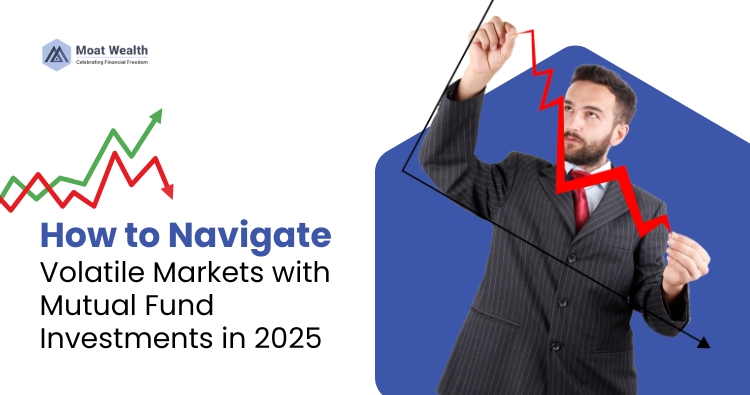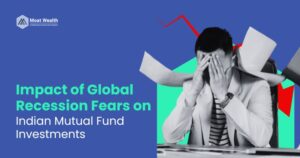In 2025, financial markets across the globe, including India, continue to grapple with heightened volatility. Geopolitical tensions, inflationary pressures, rising interest rates, and unpredictable global economic trends have created a challenging environment for investors. However, volatility also presents opportunities for those who know how to navigate it wisely. Mutual funds, with their diversification and professional management, remain a powerful tool for investors to weather market fluctuations and achieve their financial goals.
Understanding Market Volatility in 2025
Market volatility refers to the rate at which the price of securities fluctuates in the market. While periods of volatility are a natural part of financial markets, the current environment in 2025 is influenced by specific factors:
- Geopolitical Uncertainty:
- Ongoing conflicts and diplomatic tensions in key global regions continue to impact commodity prices, especially crude oil and natural gas.
- Trade policy shifts between major economies, including India’s evolving trade partnerships, have added to market unpredictability.
- Inflation and Interest Rates:
- While inflation in India has shown signs of moderation, global inflation remains a concern.
- The Reserve Bank of India (RBI) has maintained a cautious stance, balancing growth and inflation through measured interest rate changes.
- Technology and Innovation Disruptions:
- The rapid adoption of artificial intelligence, renewable energy, and digital infrastructure has created both opportunities and uncertainties for investors.
- Market sentiment often shifts based on the performance of tech-driven sectors.
- Global Economic Trends:
- Slower-than-expected growth in developed economies has impacted exports and foreign investment flows into emerging markets like India.
- Despite these challenges, India’s robust domestic demand and focus on infrastructure development have provided a degree of resilience.
Why Mutual Funds are an Ideal Tool During Volatility
Mutual funds are a favored choice for navigating volatile markets due to their inherent advantages:
- Diversification:
- Mutual funds invest across a variety of asset classes, sectors, and geographies, reducing the risk of concentration in a single investment.
- For instance, a balanced advantage fund dynamically shifts allocations between equities and debt based on market conditions, providing stability during downturns.
- Professional Management:
- Fund managers have the expertise to analyze market trends, assess risks, and make informed decisions on behalf of investors.
- This is particularly beneficial in volatile times, where timing the market can be challenging for individual investors.
- Systematic Investment Plans (SIPs):
- SIPs allow investors to invest a fixed amount regularly, regardless of market conditions. This approach leverages rupee cost averaging, where investors buy more units when prices are low and fewer units when prices are high.
- Liquidity and Flexibility:
- Mutual funds offer liquidity, enabling investors to redeem their investments partially or fully based on their financial needs.
- A wide range of schemes—equity, debt, hybrid, and sectoral funds—allows investors to align their portfolios with their risk tolerance and goals.
Navigating Volatility: Key Strategies
- Adopt a Long-Term Perspective:
- Historical data shows that equity markets have consistently delivered higher returns over the long term despite short-term volatility.
- Investors should focus on their financial goals rather than being swayed by daily market movements.
- Diversify Across Asset Classes:
- Include a mix of equities, debt, and gold in your portfolio to mitigate risks. For example, gold funds and sovereign gold bonds can act as a hedge during periods of market turmoil.
- Stick to Your Asset Allocation Plan:
- Maintain a balanced portfolio based on your risk appetite and financial objectives. Periodic rebalancing ensures that your portfolio remains aligned with your goals.
- Avoid Emotional Decision-Making:
- Volatile markets often trigger fear and panic. Resist the urge to redeem investments prematurely or shift to risk-free assets entirely.
- Instead, rely on professional advice and stick to a disciplined investment approach.
- Leverage Dynamic Funds:
- Dynamic asset allocation funds automatically adjust their equity and debt exposure based on market valuations, reducing the need for active intervention by investors.
Where to Invest: Recommended Fund Types for 2025
- Equity Funds for Growth:
- For investors with a long-term horizon, large-cap equity funds and flexi-cap funds offer stability and potential for growth.
- Mid-cap and small-cap funds may also be considered, but they come with higher risk and require a longer investment horizon.
- Debt Funds for Stability:
- Debt mutual funds, such as short-term bond funds and corporate bond funds, provide stability and are less affected by market volatility.
- For conservative investors, liquid funds and ultra-short duration funds are ideal for managing short-term goals.
- Hybrid Funds for Balanced Portfolios:
- Balanced advantage funds and aggressive hybrid funds are suitable for investors looking to balance risk and reward.
- These funds dynamically allocate between equity and debt, making them resilient during market fluctuations.
- Thematic and Sectoral Funds:
- Consider thematic funds focused on emerging sectors like renewable energy, technology, and healthcare for diversification and potential high returns.
- However, limit exposure to these funds due to their inherent risk and sector-specific concentration.
- Gold and International Funds for Diversification:
- Gold funds provide a hedge against inflation and market volatility.
- International funds allow exposure to global markets, spreading risk beyond domestic boundaries.
How Often Should You Review Your Portfolio?
Regular portfolio reviews are essential to ensure your investments remain aligned with your financial goals and the prevailing market conditions:
- Quarterly Reviews:
- Assess your portfolio every three months to evaluate the performance of your funds and make minor adjustments if required.
- Rebalance Annually:
- Rebalance your portfolio once a year to maintain the desired asset allocation. This involves selling overperforming assets and reinvesting in underperforming ones to maintain balance.
- Monitor Life Changes:
- Review your portfolio whenever you experience significant life events, such as marriage, childbirth, or a career change, to realign with new financial goals.
- Stay Updated:
- Keep track of changes in fund performance, expense ratios, and market outlooks to make informed decisions.
Current Market Outlook for Indian Investors in 2025
Despite global headwinds, India’s economic fundamentals remain robust. Key indicators influencing the market outlook include:
- Economic Growth:
- India’s GDP growth is projected to remain steady at around 6-6.5% in 2025, driven by strong domestic consumption and government-led infrastructure initiatives.
- Corporate Earnings:
- Corporate earnings growth has been resilient, with sectors such as IT, banking, renewable energy, and consumer goods leading the way.
- Foreign Investment:
- India continues to attract foreign direct investment (FDI) in emerging sectors like electric vehicles and green energy, bolstering equity markets.
- Debt Markets:
- With inflation under control, the RBI is expected to maintain a stable interest rate environment, providing opportunities in debt mutual funds.
- Global Dynamics:
- While global economic growth remains uncertain, India’s domestic-oriented economy is better positioned to weather external shocks.
Moat Wealth’s Advice for Current and Future Clients
At Moat Wealth, our primary goal is to empower our clients with informed investment strategies to navigate market challenges and capitalize on opportunities. Here’s our advice:
- Stay Invested:
- Market volatility is temporary, but the power of compounding over the long term can significantly enhance wealth creation. Avoid making impulsive decisions based on short-term market movements.
- Focus on Financial Goals:
- Your investments should be aligned with specific goals—be it retirement, child’s education, or wealth creation. Stick to your plan, and let your portfolio work for you.
- Embrace SIPs:
- Systematic Investment Plans (SIPs) are an effective way to mitigate volatility. Regular investments ensure disciplined investing and rupee cost averaging, helping you build wealth steadily.
- Seek Professional Guidance:
- Our team of experts at Moat Wealth closely monitors market trends and provides tailored advice to help you make the right investment decisions. Trust professional management to navigate uncertainties effectively.
- Diversify Strategically:
- Diversification is key to risk management. We recommend a mix of equity, debt, and alternative investments based on your risk tolerance and financial goals.
- Leverage Dynamic Funds:
- Consider investing in dynamic asset allocation funds or balanced advantage funds, which adjust automatically to market conditions, providing both growth and stability.
- Regular Portfolio Reviews:
- Ensure you review your portfolio regularly to stay on track with your goals. Moat Wealth offers periodic review sessions to optimize your investments based on market trends and personal milestones.
- Stay Informed:
- At Moat Wealth, we prioritize educating our clients. Regular updates, newsletters, and consultations ensure you stay informed about market trends and portfolio performance.
Conclusion
Market volatility is inevitable, but with the right strategies and professional guidance, it can be effectively managed. Mutual funds, with their diversification, flexibility, and expert management, remain a cornerstone of resilient investment portfolios. At Moat Wealth, we are committed to helping you navigate uncertain times with confidence and build a secure financial future. Trust us to guide you through every step of your investment journey, ensuring that your wealth grows steadily, regardless of market conditions.






